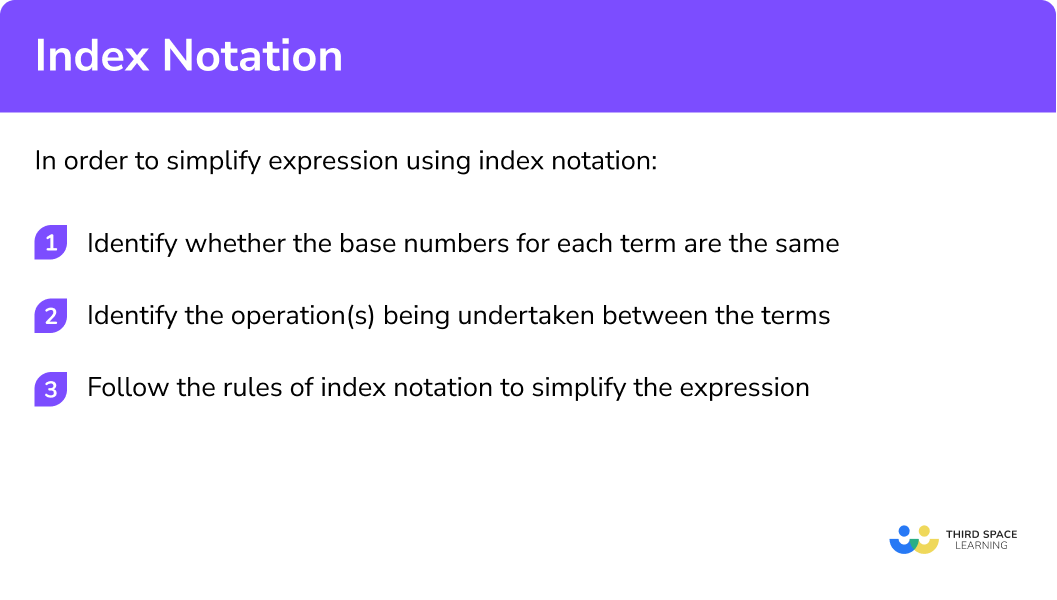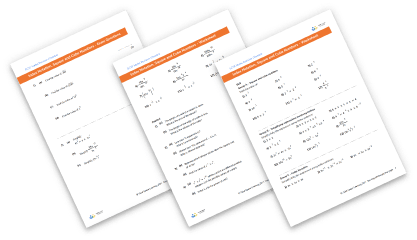One to one maths interventions built for KS4 success
Weekly online one to one GCSE maths revision lessons now available
In order to access this I need to be confident with:
Arithmetic Square numbers and square roots Cube numbers and cube rootsThis topic is relevant for:

Index Notation
Here we will learn about simple index notation including how to write an expression using index notation and how to simplify expressions written in index form.
There are also index notation worksheets based on Edexcel, AQA and OCR GCSE exam style questions, along with further guidance on where to go next if you’re still stuck.
What is index notation?
Index notation is a way of representing numbers (constants) and variables (e.g.
Below are all examples of expressions involving index notations:
We use index notations, or the plural ‘indices’, to simplify expressions or solve equations involving powers.
E.g.
Simplify
We can therefore write this as
This is said as “
E.g
Simplify
We can therefore write this as
This is said as
E.g
Simplify
In this question the term
Therefore you can write this as
This is said as
What is index notation?

Key vocabulary for index notation
Term:
A single number (constant) or variable
E.g.
In the expression
Coefficients:
The number which the variable is being multiplied by
E.g.
In
Integer:
A whole number
E.g.
Index (also called exponent or powers):
The index number is the amount of times you multiply a number/variable by itself. It is normally shown about the base number
E.g.
The index number in
Note: the plural of index is indices
Note: you will see index number as a superscript
Base Number:
The number/unknown that is being multiplied by itself an amount of times
E.g.
The base number in
Square Numbers:
A number/variable that is ‘squared’ is multiplied by itself
E.g.
A square number is found when we multiply an integer (whole number) by itself.
E.g.
Cube Number:
A number/variable that is ‘cubed’ is multiplied by itself three times.
E.g.
A cube number is found when we multiply an integer (whole number) by itself three times.
E.g.
How to simplify expressions involving index notation
- Identify whether the base numbers for each term are the same
In higher tier questions you may need to manipulate the base numbers first - Identify the operation/s being undertaken between the terms
- Follow the rules of index notation to simplifying the expression
Explain how to simplify expressions involving index notation


Index notation worksheet

Get your free index notation worksheet of 20+ questions and answers. Includes reasoning and applied questions.
DOWNLOAD FREE
Index notation worksheet

Get your free index notation worksheet of 20+ questions and answers. Includes reasoning and applied questions.
DOWNLOAD FREERelated lessons on laws of indices
Index notation is part of our series of lessons to support revision on laws of indices. You may find it helpful to start with the main laws of indices lesson for a summary of what to expect, or use the step by step guides below for further detail on individual topics. Other lessons in this series include:
Simplifying index notations examples
Example 1: finding the value of an expression involving index notation and multiplication
Simplify
- Identify whether the base numbers for each term are the same
The base number is
2 Identify the operation/s being undertaken between the terms
The terms are being multiplied.
3Follow the rules of index notation to simplify each expression
Therefore:
You will notice the index number
This is a topic we will explore further in lessons on laws of indices.
Step-by-step guide: Multiplying indices
Example 2: simplifying an expression involving unknowns and multiplication
Simplify
Identify whether the base numbers for each term are the same
The base number is
Note: the
Identify the operation/s being undertaken between the terms
The terms are being multiplied.
Follow the rules of index notation to simplify the expression
Therefore:
We can write this as:
Therefore the expression can be simplified to:
Again here you will notice the index number
Example 3: finding the value of an expression involving index notation and division
Simplify
Identify whether the base numbers for each term are the same
The base number is
Identify the operation/s being undertaken between the terms
The terms are being divided.
Follow the rules of index notation to simplify the expression
You can write
Therefore:
You will notice the index number
This is a topic we will explore further in lessons on laws of indices.
Step-by-step guide: Dividing indices
Example 4: simplifying an expression involving unknowns and division
Simplify
The base number is
The base number is
Identify the operation/s being undertaken between the terms
The terms are being divided.
Follow the rules of index notation to simplify the expression
Therefore:
You can simplify the coefficient as
You can simplify the
(see previous example)
Therefore:
You will notice the index number
This is a topic we will explore further in lessons on laws of indices.
Example 5: finding the value of an expression involving index notation and brackets
Simplify
Identify whether the base numbers for each term are the same
The base number is
Identify the operation/s being undertaken between the terms
The term
Follow the rules of index notation to simplify the expression
is equivalent to
Therefore:
(see example 1 for extended explanation)
You will notice the index number
This is a topic we will explore further in lessons on laws of indices.
Step-by-step guide: Brackets with indices
Example 6: simplifying an expression involving unknowns and brackets
Simplify
Identify whether the base numbers for each term are the same
The base number inside the brackets is
Identify the operation/s being undertaken between the terms
The term
Follow the rules of index notation to simplify the expression
is equivalent to
Therefore:
You will notice the index number
This is a topic we will explore further in lessons on laws of indices.
Step-by-step guide: Laws of indices
Negative indices, fractional indices, and power of zero
Below are three further examples involving negative indices, fractional indices and the power of zero.
For more information check out our lessons on these topics.
Example 7: a variable to the power of zero
Simplify a0
If we continue the above pattern below we can see that
E.g.
Base Number
E.g.
Base Number
This pattern is true for any base number therefore
Step-by-step guide: Power of 0
Example 8: a variable to a negative power
Write a-1 in another form
We can continue the pattern shown in example
Remember each time we reduce the power by one we are dividing the value by the base number.
E.g.
Base Number
E.g.
Base Number
Because this pattern is true for any base number,
Step-by-step guide: Negative indices
Example 9: a variable to a fractional power
Write a½ in another form
Look at the example below, see if you can spot the pattern before moving onto the next one.
When you multiply a number by itself it is called ‘squaring a number’.
The inverse of this is called square rooting.
Therefore from the above examples:
Because this pattern is true for any base number,
Step-by-step guide: Fractional indices
Common misconceptions
- Base Numbers
A common error is to incorrectly simplify expressions using the index rules where they do not share a base number.
- Index power of 1
If no index power is shown you need to remember it is being multiplied by itself ‘one time’ e.g
- Operations
A common error is to attempt to simplify an expression using the incorrect operation between the base numbers.
- Coefficients and brackets
A common error is to not include the coefficients when expanding brackets.
E.g
This should be
- Fractions and decimals
We can write fractions and decimals using index notation.
E.g.
Practice index notation questions
1. Write 8 \times 8 \times 8 \times 8 using index notation




We are multiplying 8 by itself 4 times which can be written as 8^{4} .
2. Write 3 a \times 3 a \times 3 a \times 3 a using index notation




We are multiplying 3a by itself 4 times which can be written as (3a)^{4} .
3. Simplify 5 x^{5} \times 3 x^{6}




4. Simplify z^{5} \div z^{3}




5. Simplify (3c^{4})^{2}




6. Write g^{-1} in another form




Raising a term to the power of negative 1 is the same as writing 1 over that term. g^{-1}=\frac{1}{g}
7. Find the positive value of 64^{\frac{1}{2}}




The power of \frac{1}{2} means the square root
\sqrt{64}=8
Index notation GCSE questions
1. Work out the value of:
a) 3^{3}
b) 3 \times 2^{3}
(2 Marks)
a) 3 \times 3 \times 3
= 27
(1)
b) 3 \times 8
= 24
(1)
2. Simplify fully:
a) x^{3} \times x^{3}
b) (2 x)^{4}
(2 Marks)
a) x^{6}
(1)
b) 16 x^{4}
(1)
3. Simplify fully:
a) 3 x^{6} \times 2 x^{4} \times x
b) 12 x^{5} \div 3 x^{2}
c) \left(3 x^{2}\right)^{4}
d) 4^{0}
(7 Marks)
a) 6x^{11}
Correct coefficient
(1)
Correct index number for x
(1)
b) 4x^{3}
Correct coefficient
(1)
Correct index number for x
(1)
c) 81x^{8}
Correct coefficient
(1)
Correct index number for x
(1)
d) 1
(1)
Learning checklist
You have now learned how to:
- Calculate with roots, and with integer indices
- Simplifying expressions involving sums, products and powers
- Simplify and manipulate algebraic expressions involving indices
- Simplify and manipulate algebraic expressions involving simple negative and fractional indices
The next lessons are
Still stuck?
Prepare your KS4 students for maths GCSEs success with Third Space Learning. Weekly online one to one GCSE maths revision lessons delivered by expert maths tutors.

Find out more about our GCSE maths tuition programme.